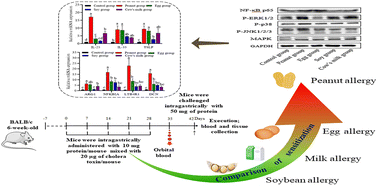Peanut allergen induces more serious allergic reactions than other allergens involving MAPK signaling pathways†
Abstract
There is no universally accepted uniform research to classify the severity of allergic reactions triggered by different food allergens. We established a food allergy model based on repeated intragastric administrations of proteins from peanut, egg, milk, or soybean mixed with cholera toxin followed by oral food challenges with a high dose of the sensitizing proteins. Increased specific IgE, specific IgG1, allergic symptom scores, histamine, murine mast cell proteases-1, vascular leakage, Th2 cytokines, and mast cell infiltration in the lungs and intestine were found in the allergic groups via enzyme-linked immunosorbent assay, hematoxylin–eosin, and toluidine blue staining. Each sensitized group showed a decrease in body temperature and Th1 cytokines after oral food challenge. The increased levels of Th2 cytokines, IL-25, IL-33, and TSLP, and related asthma genes ARG1, DCN, LTB4R1 and NFKBIA as well as the activation of MAPK signaling pathways were also revealed by quantitative real-time PCR and western blotting. In terms of the severity of food allergies, peanut allergy was the most serious followed by egg and milk, and soybean allergy was the least severe. Compared to other allergic groups, asthma genes were regulated through the MAPK signaling pathways to produce related Th2 cytokines in peanut allergy; consequently, mice in the peanut group exhibited more severe allergic reactions. Comparison of the severity of food allergies is required for the development of milder prevention for severe food allergies.



 Please wait while we load your content...
Please wait while we load your content...